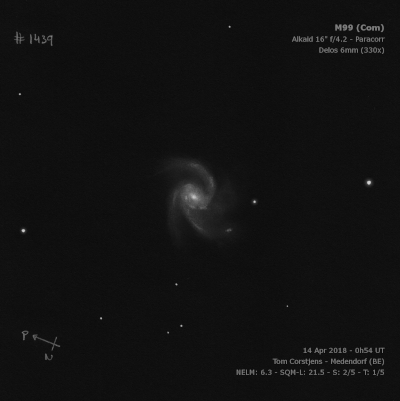Coma Pinwheel,Virgo Cluster Pinwheel
Coma Pinwheel,Virgo Cluster Pinwheel

Pierre Méchain discovered M99 = NGC 4254 = h1173 on 15 Mar 1781. William Herschel observed M99 on 14 Jan 1787 (sweep 691) and recorded, "vB. vL. vgmbM, and the brightness taking up a great space. John Herschel logged on sweep 419, "B; R; gbM; r; 5' diam."
William Parsons, the third Earl of Rosse, discovered spiral structure in April of 1846 using the 72" Leviathan of Parsonstown. The observation was made a full year after the spiral nature of M51 was discovered as LdR's attention was diverted to the Irish potato famine. M99 was the second confirmed spiral, though a month earlier NGC 2903 was noted as having a "tendency" to an "annular or spiral arrangement". On 11 Mar 1848, observing assistant William Rambaut described M99 as a "Spiral with a bright star above; a thin portion of the nebula reaches across this star and some distance past it. Principal spiral at the bottom, and turning towards the right.” Lord Rosse’s outstanding sketch showed at least 4 arms. It was published in the Philosphical Transactions of 1850 (plate XXXV, figure 2), alongside his sketch of M51. A good copy of the sketch is at http://www.wsanford.com/~wsanford/exo/rosse/index.html.
William Lassell sketched M99 on 31 Mar 1862 from Malta with his 48-inch and included three principal arms and one or two offshoots . He noted "Viewed with power 285. The spiral form is very evident, more so, I think than in any other nebula I have seen."
300/350mm - 13.1" (4/29/84): bright nuclear region. A spiral arm is easily visible attached at the SE side of core and winding almost 180° to the west. Located 10' SW of mag 6.5 HD 10710.
400/500mm - 17.5" (5/10/86): very bright, large, bright core, stellar nucleus. There is an obvious spiral arm attached at the SE side of the core and winding along the south side towards the west. There is a dark gap between the spiral arm and the core along the south and west side. A second shorter, diffuse arm is visible on the north side.
600/800mm - 24" (5/24/20): at 225x and 375x; relatively large bright circular core, ~1' diameter, increased to a very bright, small mottled nucleus. The irregular outer halo extended ~4' diameter. The brighter and larger arm was easily visible; it emerged from the east side of the core and curved counterclockwise to the south of the core and then extended to the WSW before dimming out. A very subtle brightening or knot was seen within the arm [50" S of center]. A second arm of much lower contrast began on the west side of the core and headed in the NNE direction for ~1.5' before fading into the halo. A very faint knot (NGC 4254:[HK83] 1), was visible in the outer halo on the east side [1.8' ENE of center] and was easily seen with averted. A mag 13.5 star is just outside the halo, 2' ESE of center.
900/1200mm - 48" (4/1/11): stunning view of this beautiful, asymmetric two-armed spiral at 375x. The galaxy is sharply concentrated with a brilliant 1' core that increases to a sharp stellar nucleus. The brighter more open arm is attached on the east side of the very bright core. It unwinds beautifully and expands counterclockwise for ~225° where it ends to the NW of center. As the arm passes south of the core there is a bright, well defined knot (sketched and later measured 0.9' S of the nucleus) with two additional diffuse knots in this arm 1.2' SW of center and 1.9' W of center. The arm continues to sweep north on the west side, where it is well separated from the main body.
A second long sweeping fainter arm is attached on the west side of the core and unfolds counterclockwise towards the NE. It contains a diffuse knot ~1.2' NNW of center and terminates near an ill-defined knot 2' NE of center. The halo of the galaxy is more extensive on this side and contains a prominent knot 1.8' E of center. This knot is at the end of another more ill-defined arm on the north side of the core heading east that contains additional mottled clumps.
Notes by Steve Gottlieb